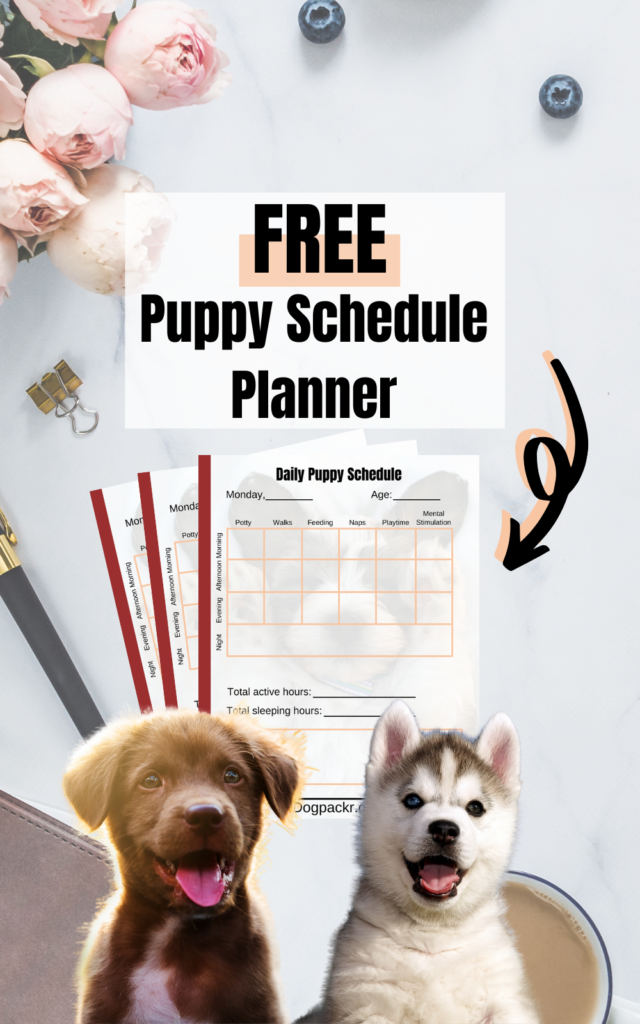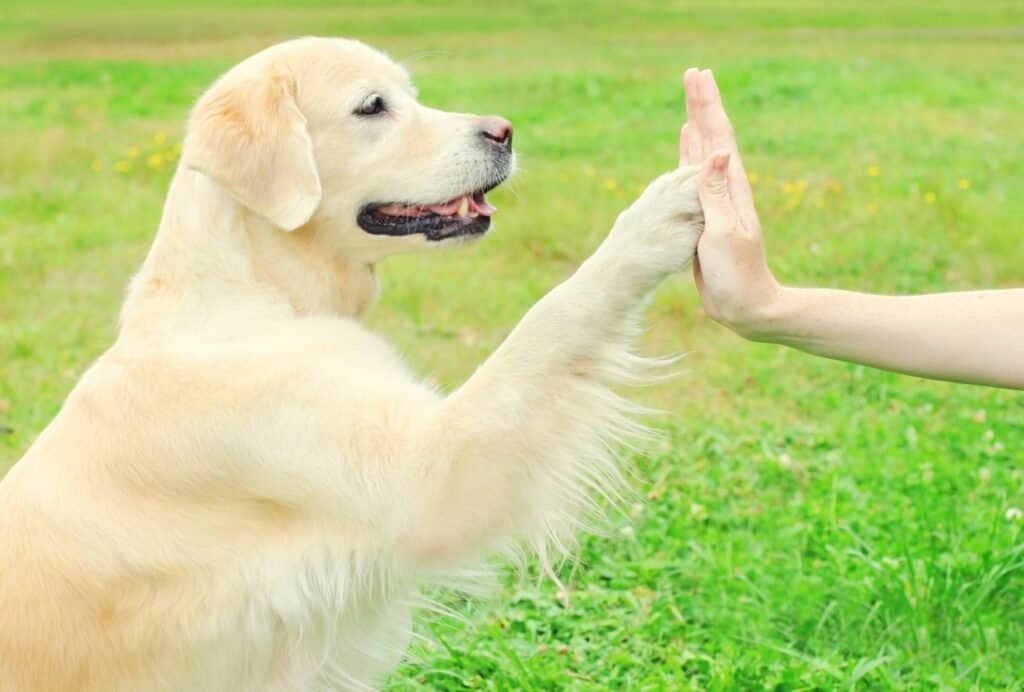
Deciding to train your dog at home can be one of the best choices you’ll make when it comes to your dog!
While it might seem a bit scary at first, you’ll soon understand that the benefits outweigh the work you’ll need to put in.
Unfortunately, I didn’t really understand that when I first got my Mini Poodle Baloo.
Instead, I rushed from dog school to private dog trainer, from one book to the next and kept getting more confused by everyone’s opinion.
While dog trainers can be an awesome help if you really get stuck with training your dog, it’s often not necessary to spend hundreds of dollars on those classes.
Instead, you can teach your dog almost everything he needs to be a well-behaved, lovely pup by yourself. This will not only save you a lot of money, but it will also strengthen the bond between the two of you!
In this article, I’ll give you 11 tips to train a dog at home. This helps you to get started with all the information you need—and it will certainly be much cheaper than what I spent on Baloo’s training…
Table of Contents
Reasons to Train a Dog at Home
Training your dog yourself might seem hard, maybe even impossible. It’s a lot of work to train your dog, and you might think you’ll be better off hiring a professional.
The reality is that training your dog at home is actually an incredibly rewarding experience! There are endless reasons to train your dog at home, but let’s go over a few of them here.
It’s Much Cheaper
Hiring a dog trainer might seem like the best course of action when it comes to training your dog.
But since you already have to pay for your dog’s food, bedding, toys, and treats, hiring a dog trainer is just one more thing you have to pay for. And not a cheap one!
And it might be an unnecessary expense too! Training your own dog is probably much easier than you might be imagining it to be.
Plus, doing it yourself saves you the hundreds or even thousands of dollars you’d have to spend on a trainer!

You Get to Bond with Your Dog Through Training
Training can be challenging. There’s no point denying it!
Sometimes you and your dog might get frustrated, and some commands might seem like they’re impossible to teach. Even if it’s not frustrating, it can simply take a while for your dog to understand what you’re asking of him.
But there will be a moment where your dog starts getting it, and that moment will be so exciting!
You’ll want to celebrate with your pup, and you’ll find that your connection to your dog gets stronger as you train him.
Training your dog yourself will definitely strengthen your bond with him. And when he starts understanding the commands you struggled with, the excitement you share will make you feel closer than ever!
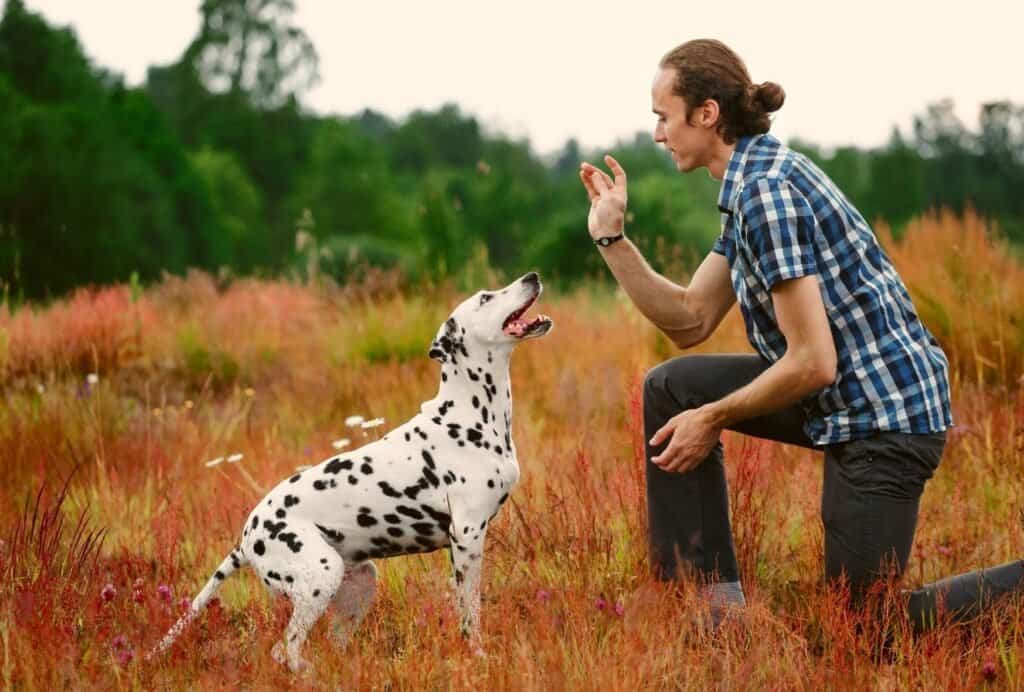
All Your Research Helps You Understand Your Dog Much Better
Training your dog will involve a lot of research! This will include the best ways to train your dog, and what the most important commands for him to learn are, but also what some of his weird behaviors mean.
As you do your research, you’ll learn a lot more about how your dog’s brain works. But more importantly, you’ll be researching a whole lot about dog behavior and canine communication.
Because from my own experience with Baloo I can tell you, you’ll encounter a bunch of odd or annoying dog behaviors that you’ll definitely want to get rid of!
And because of all of that, you’ll be able to understand your dog much better overall.
Now you’ll start seeing the reasons why he does the things he does. Instead of being confused or frustrated, you’ll understand why your dog makes certain choices, or does certain things.
Not only will this help you as you continue to train your dog at home, it will also help you become closer to your pup.
11 Tips to Train a Dog at Home
Now that we’ve talked about why it’s a good idea to train your dog at home, here are a few tips you can use for your own at home training program.
1. Always Use Positive Reinforcement
Positive reinforcement training can mean something a little different to everyone. At its heart, though, positive reinforcement means ignoring behaviors you don’t want to encourage, while rewarding behaviors you do want to encourage.
The goal of positive reinforcement is to train your dog without any negative experiences for you and your pup. Above all, it means your dog won’t experience any fear or pain during training. This is why this type of training has gained so much traction over the years.
There are different ways to train your dog with positive reinforcement. Lots of dog trainers will suggest using a clicker to help with your positive reinforcement.
Clickers can be really great and helpful tools, but they’re not necessary for positive reinforcement training. You can train your dog using just treats, toys, or whatever your dog is motivated by.
One good example for positive reinforcement dog training is Victoria Stilwell:
2. Start with Potty Training
Potty training is one of the most important things you can teach your dog. It means your dog will learn how to live respectfully in your house. It also means you won’t have to live in a stinky and unclean home.
Related article: How to stop excited or submissive dog peeing
There are plenty of different methods for house training your pup. The best way is to establish a routine, so your dog knows when it’s time to go to the bathroom. Take your puppy out every couple of hours, and reinforce him eliminating outside by rewarding him every time he does.
Here’s a step-by-step guide:
3. Crate Training Is Extremely Helpful
There are so many reasons to crate train your dog. Crates are incredibly helpful ways for your dog to feel calm and safe.
While they should never be a negative space, crates can also be a place for your dog to go for a time out if he’s getting too rowdy.
There’s far too much to say about crate training here, so be sure to check out Dogpackr’s previous article about why crate training is important, and how to do it. Also make sure to check out the 6 best dog crates and our guide to crate train an older dog.
4. Teach Your Dog His Name
Teaching your dog his name is an important way for him to bond with you. It’s also an important way to make sure he listens to you. For both of these reasons, it’s also really important that your dog loves his name.
Teach your dog his name by playing “The Name Game.” You can play this game anytime, anywhere. All you have to do is wait for your dog to look somewhere other than you. Then call his name in a way that’s happy and excited. When your dog turns to look at you, reward him!
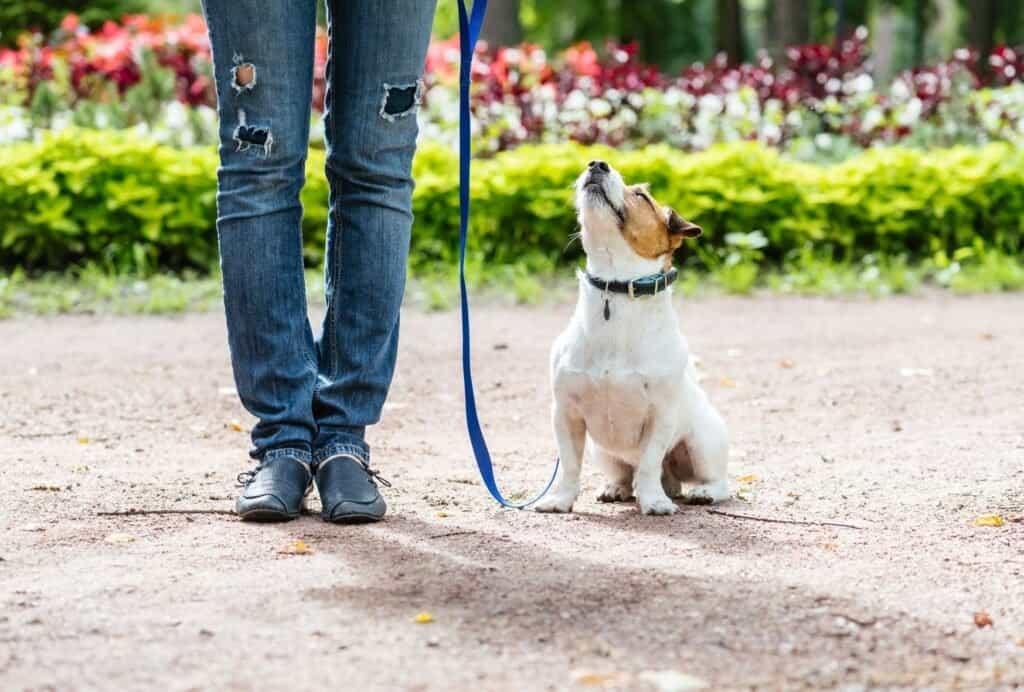
5. A Clicker Makes Practice More Precise
While clickers aren’t a necessary part of training, they can be super helpful. Lots of dog trainers swear by them!
Clicker training basically means pressing your clicker when you reward your dog. Your dog will start associating the sound of the clicker with positive feelings.
As the clicker training progresses, you’ll be able to start treating your dog less frequently, and using only the clicker. This will be faster than having to pull out a treat or a toy for your dog, which will make training more precise.
For more information on clicker training, watch Zak George’s video on the subject:
6. Socialize Your Dog or Puppy
Socializing your dog might not seem like it could be considered training, but it absolutely is. If you don’t properly socialize your dog, you might run into problems with aggression or anxiety.
Socializing your dog is an important part of training him to be a polite member of society.
Taking your dog for walks, visiting dog parks, and arranging puppy playdates are all great ways for your dog to get this necessary socialization.
Remember to use positive reinforcement while you’re socializing. Reward your dog for any good behavior he shows. This will help teach him what’s appropriate and what’s not.
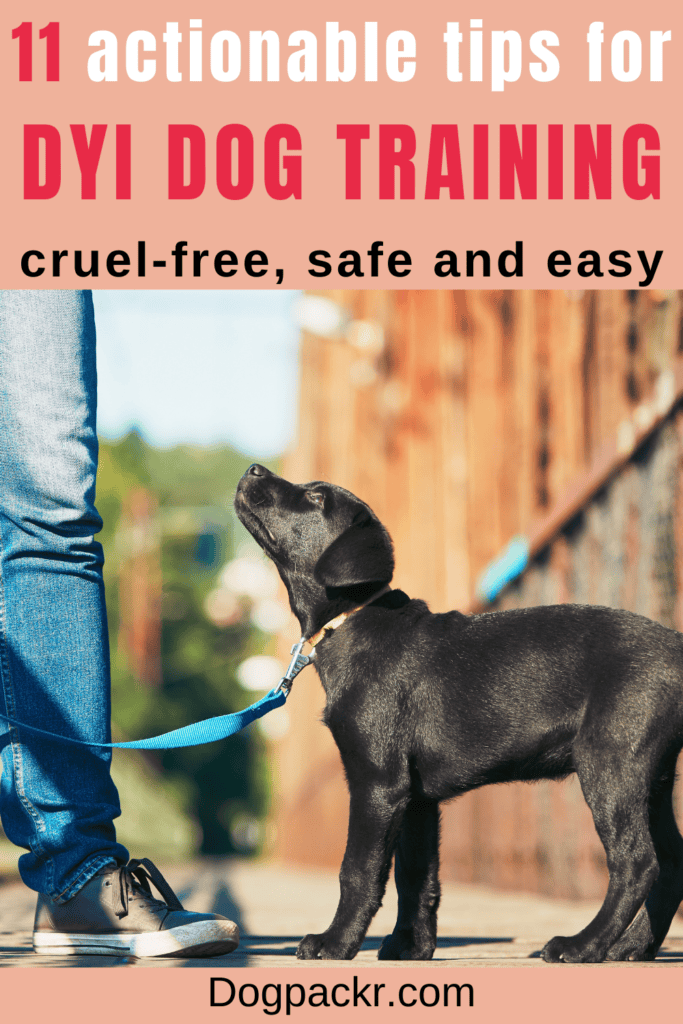
7. Teach Soft Play
Some dogs like roughhousing, but that can be painful and sometimes even dangerous. If your dog tends to be mouthy or rough when he plays, it’s important to teach him soft play.
I’ve got another article on how to stop your puppy’s biting habit, where you’ll learn everything you need to do.
Here’s the short version: If your dog tends to bite or nip while playing, let out a high pitched yelp to startle him. Then wait a few seconds, and praise your dog for not biting you. Continue doing this until your dog learns to be more gentle while you’re playing.
8. Make Training Fun by Playing Brain Games
If you’re concerned that training your dog is going to be hard and boring, then don’t worry. It doesn’t have to be! There are lots of ways to make training more fun by playing brain games with your pup.
Check out these 2 other articles where you’ll get lots of inspiration:
The best news is that these won’t just be fun for your dog, they’ll be fun for you too!
9. Establish a Routine
Having a routine for your dog is really important when it comes to training. Not only do routines help your dog know what to expect and when, they also help prevent behavioral issues. Knowing what to expect will help reduce your dog’s stress levels.
Running through a great morning routine with your dog before you head off for work, for instance, can avoid a lot of problems with separation anxiety. This is much easier on you, your dog and perhaps also on your neighbors!
Having a routine will be especially important if you’re potty training your dog. This way, your dog will know when it’s time to go. But what’s even more important is that they’ll know when it’s not time to go!
10. Teach Loose Leash Walking
If your dog is straining at the end of his leash when you go for walks, that’s not good for you or your dog. Your dog will be choking himself as you walk, plus it can cause some serious damage to your shoulder.
Teaching your dog to walk nicely on a leash can be a complicated process. Check out this video for a step-by-step guide:
11. Get BrainTraining4Dogs for Behavioral Issues
If your dog shows signs of some real behavioral problems, then I highly recommend investing in BrainTraining4Dogs. This program covers basically every behavioral issue under the sun, so you’ll be sure to find what you and your pup need.
Instead of wasting hundreds of dollars on dog schools, books and private dog trainers, this is the course I wish I had when I first got Baloo! At $47 this is an incredible bargain for the amount of value that you’ll get.
Make sure to check it out now to profit from the 60-day money-back guarantee.
Or check out Dogpackr’s review of the course first to find out if this is the right fit for you and your dog.
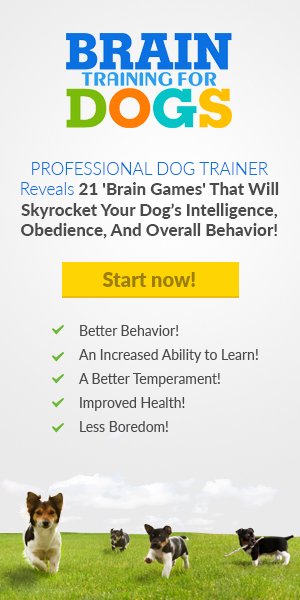
How to Train Basic Commands
So, now that we’ve covered my 11 tips to train your dog at home, let’s quickly go over some basic commands.
These commands are essential for good dog training, and so I highly recommend teaching them early on. There are six of these basic dog commands: Sit, Down, Stay, Come, Leave it and Quiet. To teach these to your dog, all you really need is treats and a space that’s not too distracting.
Sit
First, hold up a treat in front of your dog. Hold the treat to your dog’s nose so he can smell it. Then, move the treat over your dog’s nose towards his forehead. Your dog will follow the treat, which will make them put their rear on the ground. As soon as your dog sits, treat him!
Down
To teach your dog “down,” first get him into a “sit.” Then hold a treat in front of his nose. Slowly lower it to the ground. Your dog will follow the treat, like he did while you were teaching him “sit.” As soon as he lies down, he gets the treat!
Stay
In order to teach “stay,” you’ll also need a release word. This means a word that you’ll say to tell your dog he can get out of the “stay”.
The first thing you’ll do to teach your dog “stay” is to get him in either a “sit” or a “down”. Then, toss a treat to the floor. When he moves to get it, say the release word. You’ll want to repeat this until he can wait for you to say the release word, and then treat him after he moves.
Once your dog knows his release word, get him into either a sit or a down, and treat him. Then treat him for continuing to stay sitting. You can gradually increase the time he’s in his “stay.” Once he can stay for a few seconds, start adding distance between you and your dog.
Recall
This is a really important command to teach your dog. It’s best to start indoors, with few distractions, and gradually add in more distractions or head outside as your dog’s recall improves.
All you have to do is tell your dog “come” in an excited tone. You might need to pat your legs to get him to come to you. When he comes, give him his treat! Keep practicing this at greater distances as your dog’s recall improves.
For more on this particular command, I’ve recently written a whole article with tips to ensure your dog will come when called. For a quick intro, see the video below!
Leave It
To teach your dog “leave it,” you’ll want to use two types of treats. One that’s of lower value to your dog, and one that’s of high value. Hold one type in each hand and show your dog the lower value treat in a closed fist.
Say “leave it,” and wait for your dog to finish smelling the treat. When he’s done, give him the high value treat. Repeat this until he immediately stops sniffing when you tell him “leave it.”
Quiet
To teach your dog to be quiet, you’ll first need to teach him to bark on command. Find something that will trigger his barking. Tell your dog “speak” or “bark” and then use whatever you’re using to trigger the barking. When your dog barks, praise him and give him a treat.
Once your dog learns “speak,” get him to start barking. Then give the “quiet” command. Wait until he stops barking, and then once a few seconds have passed, reward him for being quiet.
With practice and consistency, your dog will eventually understand the command “quiet.”
What to Do If You Get Stuck?
Before we wrap this article up, let’s quickly go over some ways to deal with problems. Sometimes it might seem you get stuck trying to train your dog at home, but there’s always a way out!
Make Sure You Follow All of BrainTraining4Dogs’ Advice
If your dog is having trouble learning the commands you’re teaching him or he’s having behavioral issues, be sure to take a look at BrainTraining4Dogs’ advice.
It’s very important that you really try to implement every part that this course teaches you. In most cases, those brain games will help you get rid of almost every behavioral problem that you’re having with your pup!
If Nothing Else Helps: Hire a Dog Trainer
If nothing’s working for you and your dog no matter what you try, it might be time to bring in a professional trainer. Make sure you do your research and choose a trainer that focuses on positive reinforcement!
Conclusion
Training your dog at home is such a rewarding experience!
Plus there are so many amazing tools, like BrainTraining4Dogs, that are designed to help you and your dog succeed.
With practice and consistency, you’ll have an amazingly well-trained dog, and your bond will be stronger because of it.
P.s.: Don’t forget to check out Braintraining4dogs if you want to take your dog training game to the next level. It offers a 60-day money back guarantee, so you have nothing to lose.

*Disclosure: This post may contain affiliate links, meaning, I get a commission if you decide to make a purchase through one of my links, at no cost to you.

